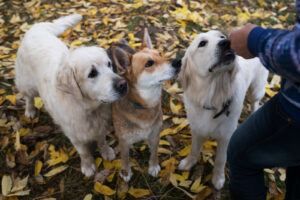Barks Blog
Banking the Positive

koldunova_anna
‘Banking the Positive’ is actually a comment I wish I could take credit for, but it’s actually something one of my clients said. She came up with it during a conversation we were having about her dog during some walk and train sessions.
The phrase perfectly captures several concepts relevant to training, such as:
- Timing
- Quitting while you’re ahead
- Not bowing to that human compulsion of pushing things too far
- Grabbing that window of opportunity with both hands
- Offering lots of lavish praise
I love it! I had to make a mental note of it at the time as I knew I’d be using it here and with many other clients from here on in.
Too Much, Too Soon
When training our dogs, are we not sometimes compelled to push things just that little bit too far? Just one more puppy sit, backing up a couple more steps when teaching ‘stay,’ testing our dog to see if he can manage to walk to the next random milestone with a slack leash, etc. And then what happens? It all falls apart!
We might ask for ‘just a couple more recalls’ when the dog’s enthusiasm is fading in an otherwise great session, or wait to get the dog’s attention just that little bit too late as he is running off to play with his friends.
When these things happen, they can be a blow to a guardian’s enthusiasm and confidence. But if that session had ended just a few minutes earlier when the dog was still engaged and responding well, both guardian and dog would have had a much more positive experience.
Most likely the guardian would return home feeling encouraged about the next session. Their behavior and attitude towards the dog may even be more positive.
Quit while you are ahead is the name of the game.
Timing
What about timing? Timing in training can be difficult to get right. Get it wrong and you risk reinforcing a behavior you don’t want your dog to repeat.
The other day I was working on some off-leash walking with a client with a very bouncy dog. We were working on building in some focal and targeting work along the way to keep the dog engaged and make sure all four paws remained firmly on the floor.
For most of this session, both did really great. But then confidence took over. We already had the dog walking beautifully and performing other skills well, all the while being positively reinforced.
Threshold
Working within this dog’s threshold equaled great behavior, but we ended up inadvertently pushing his boundaries. How? By not stopping frequently enough to reward in a timely manner.
The dog started to become frustrated. He started bouncing up and down. The timing of the reward was crucial to make sure that we didn’t inadvertently reinforce what we didn’t want the dog to be doing, i.e. bouncing up and down.
For our dogs’ benefit, we always want to ‘bank the positive,’ not only for the purposes of ‘in the moment’ but for cumulative reasons too.
Imagine you were learning something new. Say you did well one day and were rewarded for that. Then, the next two days you repeated what you had done before but then the criteria were elevated. Perhaps you became frustrated about the learning context and felt uncertain about what to do. So you tried something different and were then not reinforced for that. Perhaps you were even chastised for it. How would you feel? Not great, most likely.
Consistency
The same is true for our dogs. We must try hard to be consistent with our approach so that each learning session, whether it is a simple training objective or a more involved behavior modification protocol, is aimed at ‘banking the positive.’
We can keep sessions short enough so they have a positive outcome for each individual dog. We must work within the threshold and tolerance levels of each dog and be aware that this may change from day to day, depending upon behavioral circumstances, environmental context, and arousal level, amongst others.
We, ourselves, must bank our own positive attitude and be upbeat, kind, engaging and encouraging. If we can be all these things, and above all consistent and positive, we will see that positive change for good in our dogs.

